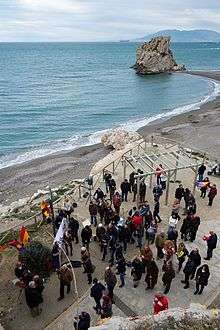Málaga–Almería road massacre
The Málaga–Almería road massacre was an attack on the republican-dominated city of Málaga, Spain and its citizens on 8 February 1937 during the Spanish Civil War. The city was penetrated by Nationalist forces and their fascist supporters. An estimated 5,000–15,000 civilians attempted to evacuate the besieged city via the N-340 coastal highway connecting Málaga to the city of Almería.
Background
On April 12, 1931, Spain had its first democratic elections since the dictatorship of Miguel Primo de Rivera. The elections resulted in the formation of the Spanish Second Republic. Consequently, a great divide was created among two of the more prevalent political ideologies of the time.[1]
El golpe de estado was a coup d’etat on July 18, 1936 by the Nationalist forces against the Republican government. As a result of the failure of the coup, the Spanish Civil War began immediately afterwards.
Aside from the capital city of Sevilla, the southern autonomous community of Andalucía (Andalusia) was primarily a Republican stronghold during the war. Málaga, a "Republican" city on the southern coast of Andalucia, was soon targeted by the Nationalist forces. On January 17, 1937, Nationalist forces led by General Queipo de Llano were sent to seize Granada, Marbella, Ronda and other surrounding areas. These actions were not perceived by Republican authorities to require immediate retaliation or preparation. However, the Nationalist force greatly outnumbered the army in Málaga. The Nationalist forces consisted of Spanish soldiers, approximately 10,000 Italian Blackshirts, German supporters, and even troops from the cities of Ceuta, Melilla, the Canary Islands and the Balearic Islands. Meanwhile, only 12,000 Republican troops were prepared to defend Málaga with 8,000 guns.
Attack on Málaga
On February 3, 1937, the Nationalist forces were met by Republican opposition in Ronda as they neared the city of Málaga. However, the defensive efforts were squashed. The city of Málaga was soon besieged by Nationalist forces. Italian Corpo Truppe Volontarie units attacked the city from the surrounding highlands on February 6, forcing the evacuation of civilians from the city. February 8, 1937 marked the fall of Málaga to Nationalist forces. The city was attacked by land, air, and sea. Troops infiltrated Málaga with guns and tanks, while Italian and German aerial and marine forces bombed and burned the city.
Due to its geographical location along the southern coast of the Mediterranean Sea and its mountainous, inland boundaries (the Sierra Morena and the Baetic System) the city of Málaga was limited in means of transport and evacuation. As a result, thousands of citizens in Málaga were left defenceless and unprepared for the attacks at the hands of the Nationalist forces. Therefore, on February 8, an estimated 15,000–50,000 civilians, chiefly the elderly, women, and children, fled towards the city of Almeria nearly 125 miles (201 km) to the northeast via the main coastal highway, the N-340 road (la carretera N-340). The frantic civilians travelled unprotected along the highway were slaughtered. The Republican Air Force was unable to halt the attacks.
Consequences
Approximately 3,000–5,000 civilians were killed en route to Almería. Mothers carrying children were slaughtered, leaving many children along the way. The elderly, the injured, and those physically, emotionally, and spiritually incapable of completing the trek were swiftly eradicated. Various accounts from the 1960s claim that corpses could still be found alongside the highway from the aerial and ground attacks.
Those who reached Almería were largely rejected by the city’s citizens out of fear of the daunting and encroaching Nationalist forces. Those who declined to evacuate Málaga (approximately 4,000 people) were systematically rounded-up, raped, killed, and piled into mass graves, such as the San Rafael Cemetery.[2]
Memoriam

The Málaga–Almería road massacre serves as a dark reminder of the political, economic, social, and religious unrest that plagued Spain during the 20th Century.
In 2005, a memorial service was initiated in Torre del Mar (approximately halfway between Málaga and Almería) to honor the victims of the massacre. Since then, it has become a tradition to create a memorial wreath for the victims every February 7.
See also
References
- Link text, additional text.
- "Link label". Archived from the original on 2015-02-26. Retrieved 2013-10-21.
- España: Ayer y Hoy: “La estructura del Estado y la vida política”.[1]
Bibliography
- Muñoz, Pedro M., y Marcelino C. Marcos. “La estructura del Estado y la vida política”. España: Ayer y Hoy. Upper Saddle River, NJ: Pearson/Prentice Hall, 2010. 204–223.
- Hernández, Javier. "El Blog De Los Kroquetas." Weblog post. El Blog De Los Kroquetas. N.p., 28 Jan. 2010. Web. 20 Oct. 2013.
- Geoff, Billett. "Geoffreybillett : Photography." Geoffrey Billett Documentary Photography. N.p., 24 Sept. 2011. Web. 20 Oct. 2013.